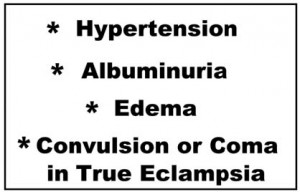Hypertension-Pregnancy-Induced (PIH) is another name for preeclampsia or eclampsia.
It is a serious, statistically important disorder characterized by the development after the twentieth week of gestation of hypertension, with albuminuria or edema or both. The exact cause of PIH is unknown.
a. Preeclampsia.
The signs of preeclampsia are referred as being classic (see figure 1-1).
(1) Hypertension. Hypertension is blood pressure, which is greater than 140/90, but less that 160/110.
(2) Albuminuria. Albumin (a protein) is not normally found in the urine.
(3) Edema. There is a swelling of the upper body (hands and face) in addition to swelling of the ankles, which is normally seen in pregnancy.
b. Eclampsia.
This refers to the progression of the above classic signs with the addition of convulsions or a coma.

c. Nursing Implications.
(1) Inform the patient to record her weight weekly and to notify the clinic if there is an excessively amount of weight gained.
(2) Inform the patient to avoid foods high in sodium content. This will reduce water retention/edema.
(3) Inform the patient that prevention of preeclampsia is essential to a healthy pregnancy and keeping scheduled OB appointments is a must.
